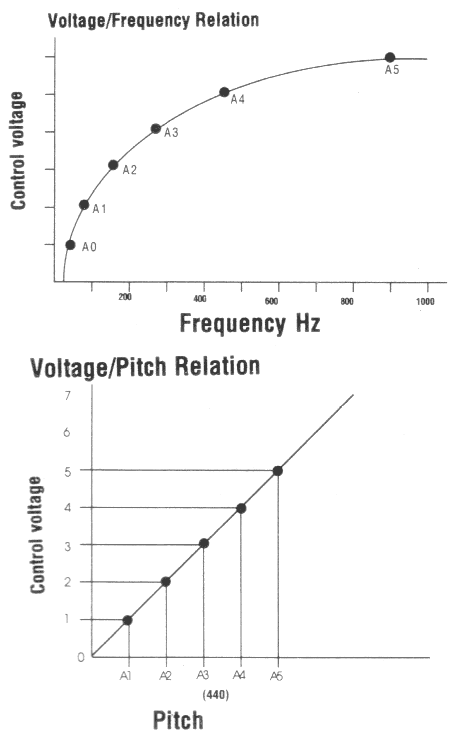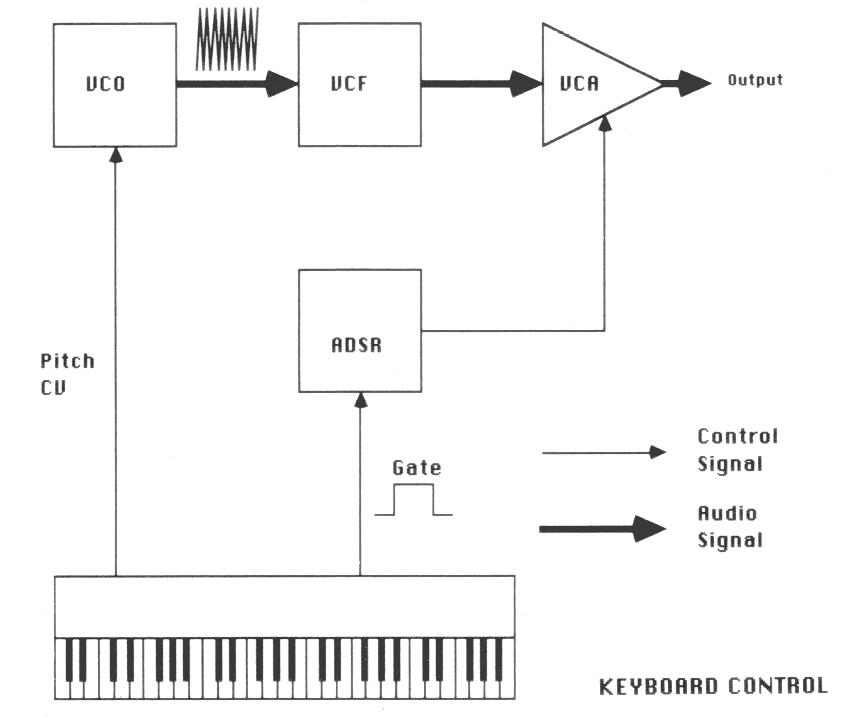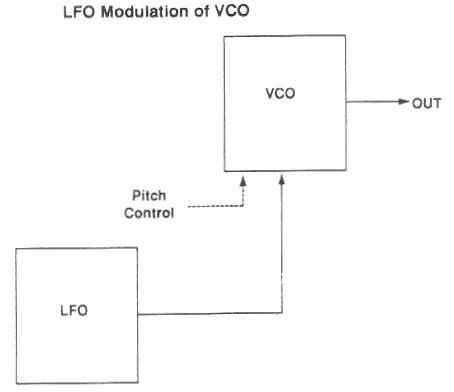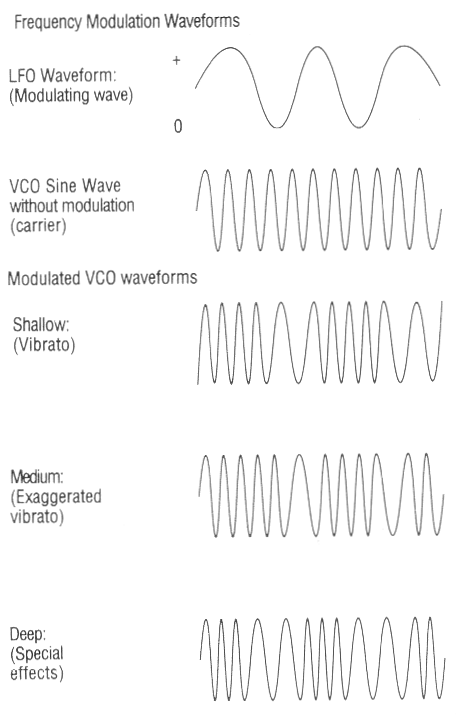
|
Part Two of Newslink's Synthesizer Course by David
Marshall
| This article uses the term Hertz (Hz). The Hertz is a measure of Frequency (ie pitch when applied to musical instruments), 1Hz being equal to one cycle per second. Scientific Middle C is 256Hz - in practice, when tuning to A44OHZ, Middle C works out to be approximately 261Hz or 261 complete cycles of a waveform per second. Doubling the Frequency raises the pitch by one octave. So the C above Middle C would be approximately 522Hz and the C below Middle C approximately 130.5Hz. |
Part 1 of this guide to basic synthesis looked
at the three fundamental elements of sound - Pitch, Timbre and Volume - and
the electronic circuits used to generate them in a synthesizer. In order
that the audio signal created by these circuits can be manipulated by a musician
a familiar 'controller' interface must be slotted into the synthesizer system.
The most common form of controller used for a synthesizer is a keyboard,
although other devices such as guitars, drum pads or wind controllers can
be used. The system of control signals used in analogue synthesizers is called
VOLTAGE CONTROL.
 |
Fig 1. |
Two types of control signal are generated, one
reflecting the pitch of the note played and the other reflecting the duration
of the note. The Pitch CV (control voltage) is a variable voltage which 'tunes'
the oscillator's fundamental frequency. The most common value used is 1 Volt
per octave, or 1/12 Volt per semitone. Therefore, on a keyboard, the note
A4 would generate a CV of 1 Volt greater than A3. (See Fig 1).
The second control signal generated is the Gate
Pulse. This is a signal of fixed voltage generated when a note is depressed
and cancelled when the note is released. The Gate signal triggers the amplifier
via the envelope (ADSR), therefore directly controlling the length of the
note. The use of voltage to control the basic elements of an analogue synthesizer
led to these elements being referred to as Voltage Controlled. In the basic
synthesizer there is a VOLTAGE CONTROLLED OSCILLATOR and AMPLIFIER, (VCO
+ VCA) and, as will be shown, a VOLTAGE CONTROLLED FILTER (VCF). (See
Fig 2).
The basic synthesizer can now generate notes
of varying pitch, timbre and duration from a keyboard or suitable controller.
Few practical synthesizers are as limited as this, and add further functions
to enliven the sound and exercise further control.
The envelope principle can be expanded to encapsulate
the filter and the oscillator. An envelope used to control the cut-off point
of the filter with respect to time will alter the quantity of upper harmonics
present. For example, using an envelope with a gradual rising attack, the
sound will appear to brighten as the cut-off point rises in line with the
envelope. The same principle can be applied to the oscillator. This time
the pitch of the fundamental frequency varies in line with the envelope shape.
Depending on the complexity of the synthesizer there may be three envelopes,
one for each of Pitch, Timbre and Volume, or a single, universal envelope
which can be assigned to any or all of these.
 |
Fig 2. |
There is a danger, especially with a keyboard
of considerable range, that having a fixed filter cut-off point will cause
large tonal differences between high and low pitches. This is not always
required. For example, consider simple square waves of fundamental frequencies
110Hz (A2), 220Hz (A3) and 440Hz (A4). Without filtering, all the waves will
sound identical in timbre despite their pitch differences. If, however, a
cut-off point is fixed at 1000Hz then the number of harmonics allowed to
pass differs greatly for each note. (See Fig 3).
In this somewhat drastic example the fixed cut-off
point for the filter turns the note A4 into a simple sine wave since only
the fundamental frequency is allowed to pass. In the case of the note A2
the filter allows a rich harmonic mix (up to the 9th harmonic) to pass. To
get round this, however, using the value of the Pitch CV, the cut-off point
can be made to track up and down in relation to the note played. This is
known as KEY FOLLOW and maintains the timbre of a sound across a large key
range. In practice, far from becoming increasingly mellow as the frequency
rises, as in the example, the timbre of an instrument is likely to become
even brighter as the pitch rises - think of the contrast between a flute's
mellow lower register and its shrill top notes.
 |
Fig 3 |
Most analogue synthesizers, therefore, have a
variable Key Follow, allowing a player to select the degree by which timbre
changes with frequency. It is worth noting that Key Follow applied to the
Amplifier can alter volume with respect to pitch. Vibrato is a fluctuation
in basic pitch. It is used by string, woodwind and brass players as a means
of adding further expression to a note. On a synthesizer, vibrato is achieved
by FREQUENCY MODULATION. A special Low FREQUENCY OSCILLATOR (LFO) produces
a selectable wave form of between 0.1 and approximately 25Hz. This wave,
sent as a CV to the main oscillator, varies the basic pitch of that oscillator
thus producing vibrato. (See Fig 4.)
 |
Fig 4. |
The basic synthesizer is now becoming more complex
There could also be more than one oscillator per voice. A mixer allows several
oscillators producing different waveforms to be added together to produce
a more complex whole. One of these further wave sources is often a noise
generator, especially useful in the creation of percussive and 'effect' sounds.
Additionally, the LFO could control the pulse wave generator so that the
width of the pulses and therefore the harmonic content of the waveform varies
with time (refer to part one of this series). The list of possibilities and
permutations could go on. (See Fig 5.)
The analogue synthesizer can therefore control
nearly all aspects of a sound. However, there are still severe limitations,
particularly in the areas of 'touch' and polyphony. Although a general volume
control is available from the amplifier (VCA), and can be modified by the
envelope, the expressive qualities of, say, a piano are absent. There is
no provision for the performer to give more or less 'weight' to individual
notes. Also, for reasons of cost the early analogue synthesizer was monophonic,
that is only one note or 'voice' could be sounded at any instant. Polyphonic
analogue synthesizers were possible but expensive. Design difficulties were
raised by increasing the number of oscillators to enable chords to be played.
These included the problem of matching CVs and Gate Pulses to the appropriate
notes, which was eradicated by the advent of digital technology and the
miniaturisation of the computer. Powerful polyphonic synthesizers were developed,
some giving the same type of control over sounds as their analogue ancestors,
some branching off in different directions.
 |
 |
Fig 5. |
Synthesizers have changed greatly over the last
ten years, but many still work on the basic principal of subtractive synthesis.
Roland's LA method, for example, includes waveform generators, filters and
amplifiers. A basic understanding of sound synthesis is something to be carried
over into new technology, not discarded.
The next issue of Newslink will look beyond basic
synthesis to some of the developments made possible by the introduction of
cost-effective micro-processors for musical instruments. If you missed the
last issue of Newslink, back copies are available from Roland on 01-568 1247.
Basic Synthesis 1 | Basic Synthesis 2 | Advanced Synthesis 1 | Advanced Synthesis 2| Sampling 1 | Sampling 2
| Chaos | Quantum | Logic | Cosmos | Conscious | Belief | Elect. | Art | Chem. | Maths |